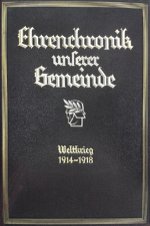A Very Brief Timeline of Jewish History in Bad Neustadt and the Surrounding Region
For an in depth information about the history of German Jewry, click here.
-
11/02/1979 12:00
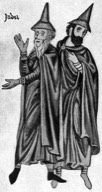
German Jews of the thirteenth century.
From Herrad von Landsperg, Luftgarten.The Middle Ages
Not much is known about the early days of the Jews in Bad Neustadt. The sources that exist teach us that Jews, in very small numbers, lived in the town from the end of the 13th century.
The 13th century was was a troubled time for the Jews. The Fourth *Lateran Council (1215) decreed that the clergy were to restrict business relations between Christians and Jews, that Jews had to wear signs distinguishing them from the Christians, and that they were not to hold any public office.
There were also laws that Jews had to wear special clothes and special pointed and coloured hats.
The Jews also had a heavy tax burden. A partial list of imperial revenue, dating from 1241, reveals that in 25 Jewish communities the Jews paid 857 marks, amounting to 12% of the entire imperial tax revenue for the year (7,127.5 marks) and 20% of the total raised in the German cities. In addition to the regular taxes the Jews also had to make payments in the form of "presents" and bribes, or money was simply extorted from them. -
11/02/1979 12:00
The Blood Libels
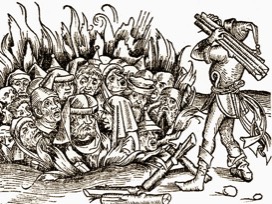
Burning of the Jews of Nuremberg, woodcut, in Hartmann Schedel's Nuremberg Chronicle (1493)
In 1235 the first case of *blood libel occurred in Germany (in *Fulda) and in the second half of the 13th century the libel of *Host desecration began to spread in the country. These accusations were to cost many Jewish lives, to cause Jews much anxiety and anguish, and to bring about further deterioration of their image in the eyes of their Christian neighbors, who now came to regard them as corrupt beings, capable of the most abominable crimes.
In 1241, when the Jews of *Frankfort on the Main tried to prevent one of their people from converting to Christianity, a Judenschlacht (Jews' slaughter) took place, in which the entire community was butchered by the Christian mob. In 1259 a synod of the Mainz archdiocese ordered that Jews within its borders should wear the yellow badge. In 1285 the entire Jewish community of *Munich - some 180 persons - was burned to death, victims of a libel that had been spread against them. -
11/02/1979 12:00
Kleinbardorf Cemetery
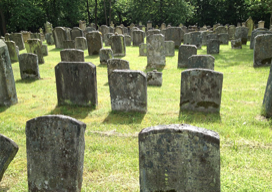 Very little is known about the local Jews during the years prior to the 19th century. It is clear however that many Jews lived in the region of Northern Bavaria. Testimony to this is the regional Jewish cemetery in a town named Kleinbardorf, not far, with over 5000 undocumented graves going back several hundred years.
Very little is known about the local Jews during the years prior to the 19th century. It is clear however that many Jews lived in the region of Northern Bavaria. Testimony to this is the regional Jewish cemetery in a town named Kleinbardorf, not far, with over 5000 undocumented graves going back several hundred years.
See 17th century manuscript -
11/02/1979 12:00
Jewish Community Life - 1860
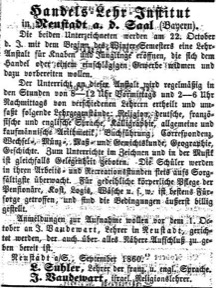
From: http://www.alemannia-judaica.de/neustadt_saale_synagoge.htm
A Jewish trade-Teaching Institute was opened (1860)
Article in the "Allgemeine Zeitung of Judaism" of 25 September 1860.
"Trade-teaching institute in Neustadt an der Saale (Bavaria)
The two undersigned will on 22 October this year with the start of the winter-semester teaching a Institute for boys and youths open, devoted to trading or a relevant trade and prepare to want.
The instruction at this institution is regularly issued in the hours of 8-12 and 2-6 clock clock morning afternoon by different teachers and teaching includes the following items: Religion, German, French and English language, calligraphy, general and commercial arithmetic, bookkeeping, correspondence , exchange, coinage, weights and measures studies, geography, history. For lessons in drawing and music opportunity is offered also. Students are always supervised in their work and Rekreationsstunden most carefully. For prosperous physical care of retirees, board, lodging, laundry, etc. care is well taken, and the conditions are made very cheap.
Applications for receiving wish to be addressed prior to October 1 at J. Vandewart, teachers in New Town, which is also to give more detailed information about everything already.
Neustadt a / S. September 1860th
L. Suhler, teacher of French and English language.
J. Vandewart, Israelite religion teacher. " -
11/02/1979 12:00
Local Cemetery
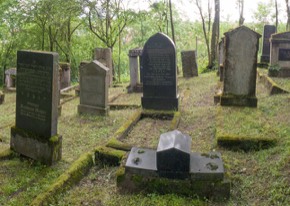 The community began to gradually grow from the beginning of the 19th century.
The community began to gradually grow from the beginning of the 19th century.
The modern Jewish community was founded in the 1860s. That year, local Jews purchased a building as the venue for a community center, school and prayer hall.
Like in many communities a burial ground was set up before a local synagogue was built. In 1887 a local Jewish cemetery was inaugurated. -
11/02/1979 12:00
Antisemitism 19th Century
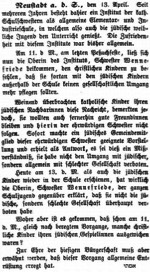
From: http://www.alemannia-judaica.de/neustadt_saale_synagoge.htm
Article in the magazine "The Israelite" of 29 April 1863. "Neustadt adS, the April 13 (1863)
For several years, there dahier an institution of the Catholic school sisters as a general elementary school and industry, in which including the Jewish female Youth enjoys teaching. satisfaction with this institution was previously general.
On the 11th of this month, on the last Passover celebrations, now the Mother Superior of the Institute, sister Wennefriede let himself get at to command the Christian children that they should henceforth maintain no social intercourse with more Jewish children outside the school.
Crying over Catholic children brought their Jewish neighbors this message, noticed however, they also wanted to remain henceforth good friends and do not follow herein the venerable sister. Immediately made a Jewish community member of this venerable sister appropriate presentation and received in reply, whether this is a misunderstanding, it did not deal with the Jewish state, but generally banned with bad company.
Appeared back in school today on 13th of this month, as well as the Jewish children, really the superior, Sister Wennefriede, the whole school youth has over us that they have not banned altogether Jewish, but bad company.
But whence it has come already on 11th of this month, right after beregtem processes, some Christian children were evaded their Jewish playmates?
To honor the local citizenry but it must be mentioned that this process has caused general indignation. " -
11/02/1979 12:00
The Synagogue
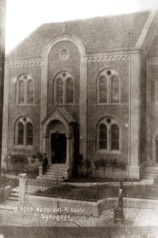 The local synagogue was built in 1892 on a street then known as Bauerngasse, until that point the community would congregate in a building purchased in 1860 that served as a school, living quarters and a community centre. Not much is known about the community leaders, however snippets of news and advertisements from the local newspaper give us a glimpse into the daily lives of the simple folk. Traders and merchants, teachers and religious leaders.
The local synagogue was built in 1892 on a street then known as Bauerngasse, until that point the community would congregate in a building purchased in 1860 that served as a school, living quarters and a community centre. Not much is known about the community leaders, however snippets of news and advertisements from the local newspaper give us a glimpse into the daily lives of the simple folk. Traders and merchants, teachers and religious leaders. -
11/02/1979 12:00
World War 1
The Jewish citizens of Bad Neustadt regarded themselves first and foremost as loyal German citizens.
This was made clearly apparent in their active participation in the ranks of the German army during World War 1, in which many gave their lives.
The names and details of the Bad Neustadt soldiers who fought during the war are commemorated in an album safeguarded the the Bad Neustadt archive. -
11/02/1979 12:00
Antisemitism & The Nazi Party
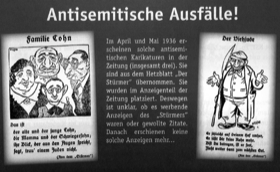
Antisemitic cartoons from local Bad Neustadt newspaper, 1932
When the Nazi party was elected to government in 1933, a wave of persecutions against the Jews began in the town, including a series of limitations on day to day activities, investigations of community leaders and forced labour. The grave stones in the cemetery were desecrated twice (March 1936 and November 1938) and the synagogue was damaged several times as well. In 1938, on the first day of the Jewish New Year holiday (September 26), the community leaders were ordered to clear out the synagogue immediately; the German army appropriated the building for grain storage. Thereafter the community held its prayer services in the school building. -
11/02/1979 12:00
The Holocaust
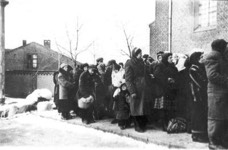
Izbica, 1942
In 1940, the synagogue’s metal objects were confiscated for scrap. Jewish gravestones were smashed on Pogrom Night; thirteen Jews were arrested.
As a result of the persecution the majority of the community (74) migrated, 35 relocated within Germany and eight died in the town.
On February 1942, there were only 56 Jews in the town. The final transfer of the remaining Jews took place Between February and August, 1942. The Jews were transferred to Wurzburg and from there to Izbica (adjacent to Lublin) or to Ghetto Theresienstadt. At least 81 local Jews perished in the Shoah. -
11/02/1979 12:00
After the War
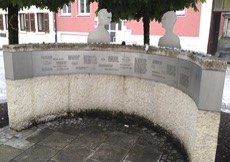
Memorial for the Jews of Bad Neustadt
After the war no one from the original community returned. The Synagogue still stands, and true to today it serves as an apartment building and doctor's clinic. The old community building stands abandoned and shut. Since 2013 The cemetery in is maintained by the municipality. A memorial for the Jews of Bad Neustadt who died in the Holocaust was erected at the site.
